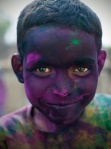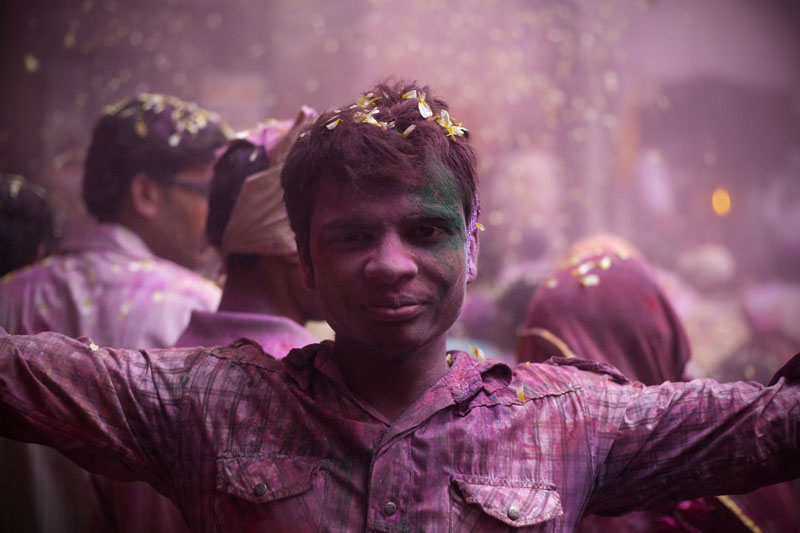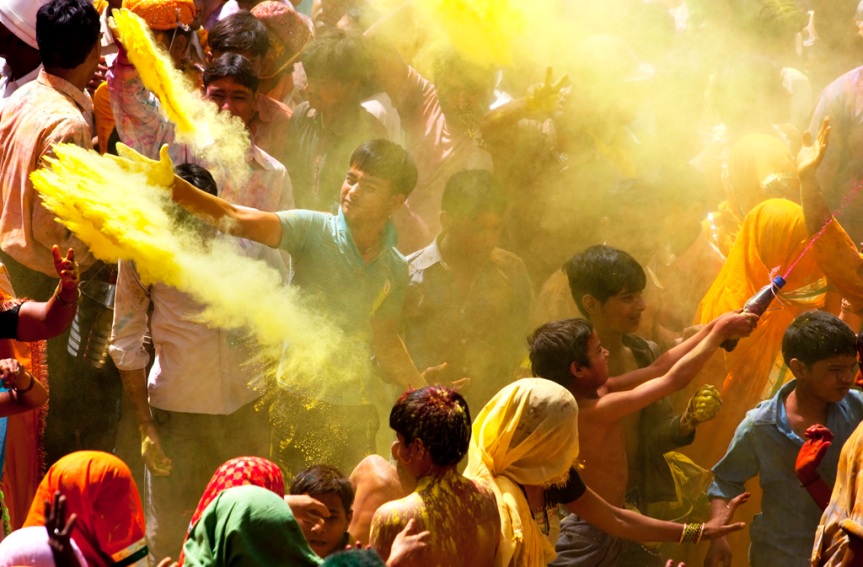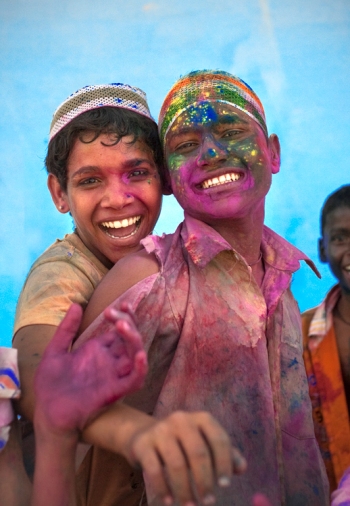If you’re going to Holi for the first time, you’re in for a memorable experience. It can be tricky to shoot it – your gear will definitely get covered in powdered paint and it’s as chaotic as they say – but aside from that it’s one of the most colourful festivals in the world and you will undoubtedly get some memorable shots if you get in amongst it.
Holi 2012 takes place on the 8th March and I’ve put together some tips and advice to help photographers prepare and try to get the best possible shots.

1. Protecting your camera
This will be an obvious concern, and there are all kinds of options available – from underwater housing to plastic bags – but from my experience last year and from seeing what other photographers used, dedicated rain covers seem like the best choice. Even using those, your camera and lenses will still get a coating because the stuff just gets absolutely everywhere. The good news is that it seems to clean up pretty well if you get a professional cleaning afterwards.
2. Protecting yourself!
 I didn’t do this but apparently if mustard oil is applied the night before, it is supposed to work wonders for making sure the colours don’t seep into your skin and hair too much. I guess you won’t smell too great but it’ll be worth it! I was lucky that the colour came out after 2-3 days but I’ve heard stories of it lasting for weeks so the mustard oil might be a good investment. And it goes without saying that you should wear old clothes and shoes!
I didn’t do this but apparently if mustard oil is applied the night before, it is supposed to work wonders for making sure the colours don’t seep into your skin and hair too much. I guess you won’t smell too great but it’ll be worth it! I was lucky that the colour came out after 2-3 days but I’ve heard stories of it lasting for weeks so the mustard oil might be a good investment. And it goes without saying that you should wear old clothes and shoes!
3. Find out where the main events will be
The temples I ended up at in Mathura where the places I got the best shots, and without some local knowledge I would never have known how to find them. Wherever you’ll be for Holi, find out in advance what is happening and when, then plan some local travel. And if you know what sort of place you’re going to, you can already have a good idea of how to shoot once you get there.
4. Choose your lenses carefully
You will quickly find out that changing lenses is a nightmare. Often there’s no break from the chaos and no quiet corner to escape to for a moment, so you’ll need to be strategic about it. If you’ve asked around and done a bit of research, you should know a little about what to expect at certain times so that gives you a head start.
If you have the options, I’d advise two approaches; firstly a fast prime for shooting portraits and crowd scenes from up close. A 35mm with an aperture of 1.8 or wider would be perfect. This is the sort of lens you want to be using when you’re ‘in the thick of it’, either in temples or in the streets. I’ve seen photographers using a very wide angle lens like a 16-35mm or 17-40mm, but again it would have to be very fast to cope with some of the the low light conditions.

A fast prime lens is perfect for shooting portraits and crowd scenes in temples
At other times, you should look for a vantage point where you can shoot crowds from above. Here, a telephoto zoom would be ideal, something like a 70-200 or 70-300. In temples, you’ll need something fast like a 2.8 aperture otherwise there simply isn’t enough light. But outside in daylight, an aperture of 5.6 is perfectly fine. If you know you’re gear and what it is and isn’t capable of, you can plan accordingly.
If you have two bodies then it will make a big difference although I have to admit that I only used my back-up camera (a Canon 5d).

Look out for vantage points and try to find the likely powder throwers
5. Put UV filters on your lenses
You’ll need to protect your lenses and UV filters are perfect because they don’t cut out any of the light hitting the sensor. As a general rule, the more expensive filters give a better clarity of photo and I would normally try to use a top brand of filter.
At Holi though, I used the cheapest I find while out in India – basically they were the only ones I could get hold of – but they didn’t have a hugely detrimental effect on the photos in this case. If you can afford the best, go for it. But cheap ones are better than none at all and they shouldn’t stop you getting good shots.
6. You will definitely get drenched in colour!
If you think you might get away with finding a nice vantage point and keeping both yourself and you’re gear colour free, think again. But I’m sure most people photographing Holi will want to get into the action anyway. People won’t back off though simply because you have an expensive camera around your neck, and if you’re a foreigner they will want to make sure you get a full Holi experience so you’ll definitely get many dousings of paint!
It might even be worth getting into the action for a short while without your gear to make sure you get covered beforehand. From my experience, it should only take a few minutes before that happens! Once you’re covered, you’ll be less of a target and can then concentrate more on shooting. Or you might not! But it’s worth a try.

7. Stay safe
People are in high spirits and enjoying themselves during Holi, and it can get pretty boisterous and even overwhelming if you aren’t prepared for it. Available taxi’s and buses can be almost impossible to find at times, so if you’re going out to temples and more remote places, don’t go alone.
Go with fellow travelers, locals you might have met beforehand, or even a guide. If you can arrange local travel beforehand it will be well worth it to avoid potentially hours of waiting around trying to get back to where you’re staying. And as with any big crowded event, probably best to leave other valuables back at the hotel.
People might throw powder directly into your face at times, so try to be careful not to get any in your eyes. Easier said than done, I know!
8. Use back button focusing
Obviously people are in high spirits and more than happy to be photographed. The hardest part is that they’re often moving about a lot and somebody might jump in front of the lens as you’re shooting a group. I’d recommend using back button focus to cope with this. You can do this on most dSLRs and will need to consult your manual (or google it) to find out how to set it, but basically it means that a button on the back of your camera will now be the focus button, leaving the shutter button free to do only one thing – take the photo.
Essentially, the shutter button no longer focuses on half press. So if you focus on a group with the back button, the focus is locked there until you change it. The camera can’t suddenly re-focus on a moving person coming into the frame when you don’t want it to. If you’re going to do this though, make sure you’re camera is set up correctly and that you’ve practiced in advance as it takes a little getting used to. Once you’re used to it though you might never go back.

Back button focusing works well with Holi festival
9. Take enough memory and battery power
These are obviously basics but you’ll be amazed at how many shots you take. With all of the challenges I’ve mentioned so far, Holi is definitely the sort of event where it’s worth shooting a lot of frames and editing your selection later. Just keep shooting, pay attention to what you’re doing technically, and worry about deleting the surplus shots later. To do that you will need a lot of memory.
10. Take it all in
Aside from getting the photos, make sure you enjoy it and take it all in, not only through the viewfinder. And if you take a step back and stop shooting now and again, you can watch what’s going on and identify those throwing the powder and those most likely to do something worth shooting. It could help you to get better shots and enjoy what’s going on even more. Enjoy!
See my gallery of images from Holi 2011
Licence images of Holi festival from Getty Images
Find me on other channels and websites:
Categories: Uncategorized


Very useful post, now that holi is again round the corner, will be able to use the tips given.
LikeLike
Thanks, glad you liked the post – wish I was going again this year!
LikeLike
useful…thanks…
LikeLike
Great post and tips, thanks very much for taking the time to write about your experiences 🙂 Where about did you go? Any advice for which places to visit would be much appreciated.
LikeLike
Thanks Mark, glad you enjoyed the post. I went to Mathura which is about 2-3 hours from Delhi. Mathura is the birthplace of Krishna and therefore has the biggest celebrations every year, so it’s the obvious place to go for Holi. But as far as I know, Holi is played out throughout much of Northern India. I have thought that somewhere like Jodhpur would be a great place to photograph Holi because it is such a colourful, blue city and would provide a great setting and backdrop, but I haven’t visited there during Holi so can only comment on Mathura really. If you have anything specific you want to know about Mathura just shout and I’ll see if I can remember!
LikeLike
Hi! really thanks for your tips here!
I’m planning a photo-trip to Holi with a friend on 2014, and your post will be of BIG help! 🙂
Would you suggest any guide agency or something to get a guide for the trip?
cheers 😉
LikeLike
Hi Marco, thanks, glad you found it useful. Yes I’d recommend a guide because it’s quite tricky to find the right places without some local knowledge. You can try Lightstalkers.org as place to find guides, I worked with a guy called Dinesh Dubey who was very good. Enjoy!
LikeLiked by 1 person
Thank you for all this informations about holi .
i plan go to holi festival (2014). Do you know How Many Time before it´s better arrive in the City ?
I want go to Vrindavran an Mathura. Which places are better in this 2city? Is it´ Easy to Take photo from higth position inside temples? If you some recommandations for best shoot photography i listen you with pleasure.
Thank you,
Marcel from France
LikeLike
Marcel, I’m very sorry for the late reply! I arrived in Mathura the day of the festival itself, and within 2 hours of checking into my hotel I hurridly found the temple where that day’s main events were taking place. I would recommend arriving the day before so you have more time, know exactly where to go and how to get there, and can have a lot of time to shoot. I’m afraid I can’t help with regards to identifying particular locations since I worked with a local fixer who got me to the right places so I didn’t pay too much attention to that. Within the temple on that first afternoon, I did briefly get into a high position but again this was essentially due to the local fixer – for some reason the police in the temple were not keen on me spending too much time in there, or being able to climb up the stairs for a vantage point, so local help was invaluable. The second day nothing spectacular happened (walking around villages shooting a few portraits, and all the action takes place from morning to mid-day, not much went on after that. The third day was great, at another temple where people are showered with paint and water as they celebrate holi. I managed to get a good spot and it was clearly the main place to be because there were several photographers from Reuters and other news agencies. I’m sorry I don’t have exact location info, but you can contact the guy I worked with (his name is Dinesh Dubey, google his name and ‘lightstalkers’). He might be able to help you either with actually going with you, or alternatively just filling in the location info which I’m missing above). Good luck, and enjoy!
LikeLike
Holi Festival takes place during the spring season when the countryside is bathed in a riot of colours. there are some good tips. just like Protecting your camera, Protecting yourself, Stay safe and many more.
http://www.journeymart.com/holidays-ideas/festivals/holi.aspx
LikeLike
Thank You very much…….Now I think so that I’ll get better shots and also keep my gear safe…. Once Again Thank You! ! !
LikeLike
Thanks this is just what i was looking for! im going for holi festival next year in 2015, also i wanted to ask u, did you went to Mathura? im looking for places where to sleep, maybe u can guide me on that, thanks again
LikeLiked by 1 person
Great job capturing the spirit and joy of these people. Love your photography.
LikeLike